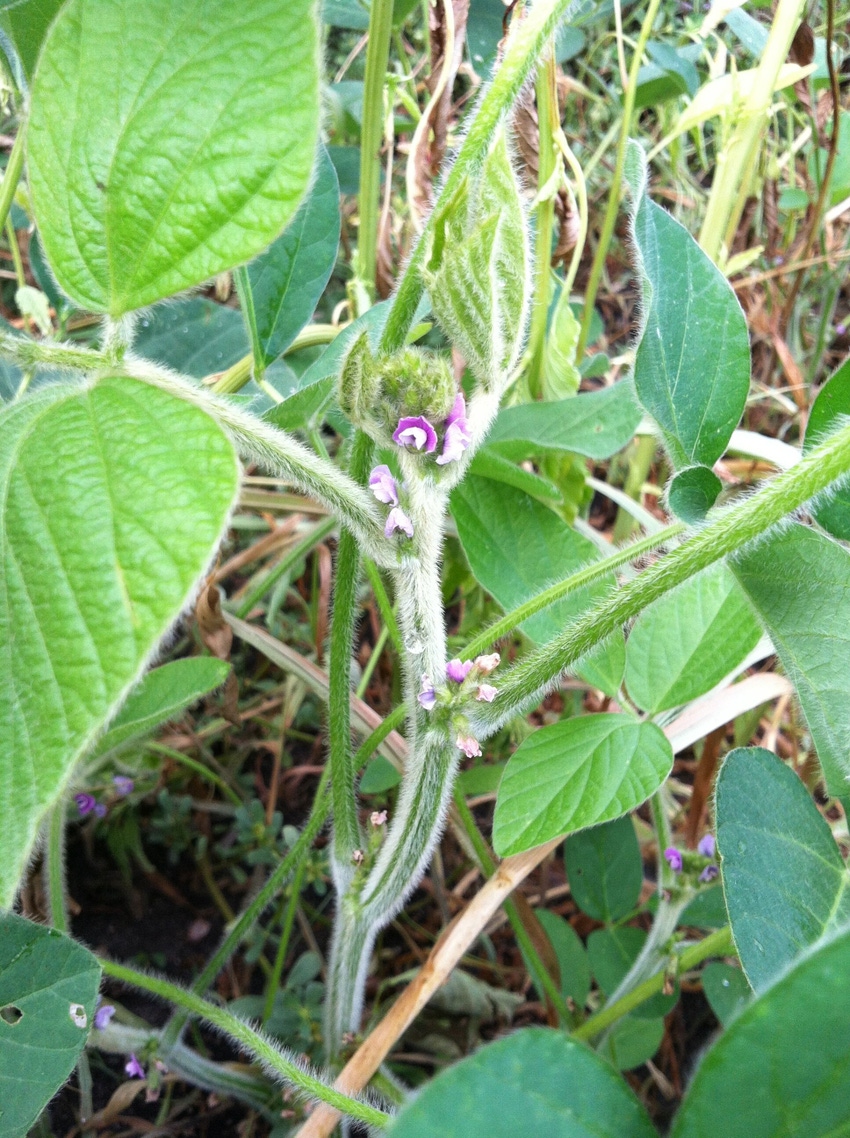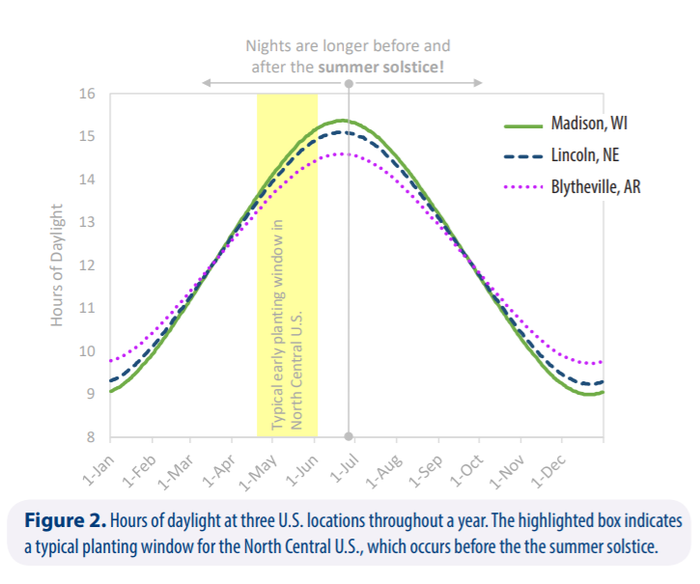July 23, 2018

Source: University of Wisconsin-Madison and University of Nebraska Institute of Agriculture and Natural Resources
In a bean pod…
There is an old rule-of-thumb that soybean does not flower until after the summer solstice — the longest day of the year occurring on June 21st in the Northern Hemisphere — yet many of us have seen soybean flower much earlier.
Early planted soybean experience shorter days before June 21st, so floral induction and the subsequent appearance of flowers may occur ahead of the summer solstice.
Soybean management decisions depend on proper identification of reproductive stage R1 (1st flower), which means relying on scouting to observe flowers, not calendar date.
Soybean is a ‘short-day’ plant.
Nearly all plant species depend on seasonal change in day/night length as a cue for initiating flowering so that it occurs at a seasonally optimum time. In both natural and cultivated systems, this ensures successful pollination, seed fill, and dispersal/harvest. In crop species, breeders can genetically develop cultivars that have specific adaptation to latitudinal zones of north-south variance in day/night photoperiod. This is a major reason that different soybean maturity groups are grown at different latitudes (Mourtzinis and Conley, 2017).
There are two main types of plant species photoperiod dependency, known as ‘long-day’ and ‘short-day’. These historically assigned names are misleading; we now know plants actually measure the length of the night, not the day.
For both types, there is a critical night length that varies between species and among wild ecotypes or crop cultivars adapted to different latitudes. For most short-day plants (like soybean), exposure to a few successive nights longer than the critical length will induce flowering. Long-day plants require the successive nights to be shorter than the critical night length to flower (Taiz et al., 2015; Figure 1).

There are two cyclic processes at play in the mechanism of photoperiod sensitivity: 1) the solar 24-hour cycle of day and night, and 2) a within-plant circadian rhythm. This circadian rhythm also keeps time, but because it does not precisely do so, it must be entrained to keep ‘plant time’ close to 24-hour solar time.
A protein found in plant leaves called phytochrome is responsible for photoperiod detection. This protein is converted into an active form by sunlight and returns to an inactive form in the dark. Expression of certain genes in the plant are controlled by circadian rhythm, increasing expression at specific time intervals.
When expression of these ‘clock’ genes occurs in the daylight, a signal that induces flowering (GmFT) is repressed, so flowering does not occur (Taiz et al., 2015; Cao et al., 2016). This model is consistent with the mechanism that controls flowering in rice, which is a model short-day plant. These mechanisms in soybean are less well understood than in rice, in part because there are multiple, redundant genes in soybean, which may allow some soybean cultivars to have reduced photoperiod sensitivity (Cao et al., 2016).
The molecular mechanisms that control soybean photoperiod sensitivity and flowering induction are areas of ongoing research. The exact mechanism of perceiving night length and floral induction is complex, but the main idea is that longer nights, which is perceived by the leaves, induce flowering in soybean (Figure 1).
Nights are long before the solstice, too!
Research on this subject has shown that in soybean, the unifoliate leaves are able to perceive night length. If the night is long enough, those leaves will transmit a signal to leaf axil vegetative meristems that induces them to become floral meristems (Wilkerson et al., 1989). If soybean are planted early enough, flower induction can occur before the summer solstice when nights are long (Bastidas et al., 2008).
Typical planting dates in the North Central U.S. occur well before the shortest-night of the year (e.g., solstice), generally providing unifoliate leaves opportunity to perceive long nights as soon as they emerge (Figure 2).

Floral Induction, does that mean R1?
Induction of flowering occurs long before your eyes can observe flowers on the plant. This refers to the very first chemical signals in the plant that cause the meristematic tissue to begin forming a flower instead of a branch in each leaf axil. In soybean, those signals are photoperiod dependent, requiring long nights. Flower evocation refers to the growth of that differentiated tissue to result in a visible flower.
The speed of that growth is temperature dependent, much like growth of vegetative tissue. In general, higher temperatures result in faster growth. The first reproductive growth stage (R1) is only noted after the human eye can see flowers (Fehr and Caviness, 1977).
Therefore, both induction and evocation are required to reach R1, meaning that photoperiod and temperature will impact the timing of R1. Perception of an inductive night length is needed to initiate flowering, but temperature increases can speed up flower evocation. A very warm late spring could lead to hastened R1 timing, which was observed in the Midwest in 2018.
Maturity group is a reflection of photoperiod sensitivity.
Night length changes over the course of the year, but the magnitude of this change is latitude dependent. Higher latitudes experience a longer period of sunlight on the longest day, and therefore a shorter night.
Soybean grown at higher latitudes are able to flower under these shorter nights because maturity groups adapted for these locations have reduced photoperiod sensitivity (Cao et al., 2016). For example, Madison, WI (latitude 43.0°) experiences a night length about 15 minutes shorter on June 21st than Lincoln, NE (latitude 40.8°) and about 45 minutes shorter than Blytheville, AR (latitude 35.9°) (Figure 2). Soybean maturity groups II and III are best suited to southern Wisconsin and Nebraska, respectively, and are less photoperiod sensitive than the maturity group IV or V soybean typically grown in Arkansas (Mourtzinis and Conley, 2017).
Why does early flowering matter?
In future growing seasons, increasing frequency of extreme warm and cool temperature fluctuations during the floral evocation period can result in increased variability of R1 timing after V1. Since early planted soybeans are able to perceive long nights before the solstice, we cannot count on June 21st as the typical R1 date in the North Central U.S. The best way to identify the timing of R1 is to regularly scout soybean. Crop models like SoySim predict growth stages by using planting date, maturity group, photoperiod, and temperature data, plus projection of coming temperatures.
Predictors like this can be useful management tools but should be validated in the field. Identifying R1 is important for effective weed and disease management. Several common post-emergent herbicides are not labeled for use in soybean after R1. The legal application window for these products refers to the growth stage present in the field, regardless of the calendar date.
For disease management, earlier white mold risk comes with early flowering soybean. Sporecaster, a white mold predictor app, can aid in white mold management but only with accurate information about the presence of flowers.
Relying on the calendar for R1 determination increases your risk for missing the window for an effective fungicide application. The advances in agricultural production in the last century have allowed increased food production on less acres, and this pattern needs to continue in order to feed a growing global population.
New technologies and modern crop management strategies (like planting earlier) along with extreme weather patterns becoming more frequent, will challenge us to be wary of old rules-of thumb that may not hold up to farming in the 21st century and beyond.
Literature cited:
Bastidas, A.M., T.D. Setiyono, A. Dobermann, K.G. Cassman, R.W. Elmore, G.L. Graef, and J.E. Specht. 2008. Soybean sowing date: The vegetative, reproductive, and agronomic impacts. Crop Sci. 48(2): 727–740. Cao, D., R. Takeshima, C. Zhao, B. Liu, A. Jun, and F. Kong. 2016. Molecular mechanisms of flowering under long days and stem growth habit in soybean. J. Exp. Bot. 68(8): erw394Available at https://academic.oup.com/ jxb/article-lookup/doi/10.1093/jxb/erw394 (verified 18 July 2018). Fehr, W.R., and C.E. Caviness. 1977. Stages of soybean development. Iowa State University Cooperative Extension Service, Special Report 80. Mourtzinis, S., and S.P. Conley. 2017. Delineating soybean maturity groups across the United States. Agron. J. 109(4): 1397–1403. Taiz, L., E. Zeiger, I.M. Maller, and A. Murphy. 2015. Plant physiology and development. 6th ed. Sinauer Associates. Wilkerson, G.G., J.W. Jones, K.J. Boote, and G.S. Buol. 1989. Photoperiodically sensitive interval in time to flower of soybean. Crop Sci. 29(3): 721.
Originally posted by the University of Wisconsin-Madison.
About the Author(s)
You May Also Like




